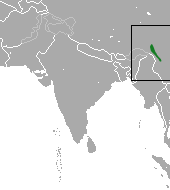Black-and-white snub-nosed monkey facts for kids
Quick facts for kids Black-and-white snub-nosed monkey |
|
|---|---|
 |
|
| Conservation status | |
| Scientific classification | |
| Genus: |
Rhinopithecus
|
| Species: |
bieti
|
 |
|
| Black snub-nosed monkey range | |
The black-and-white snub-nosed monkey (Rhinopithecus bieti), also known as the Yunnan snub-nosed monkey, is a large black and white primate. It lives only in the southern Chinese province of Yunnan. Local people call it the Yunnan golden hair monkey or the black-and-white snub-nosed monkey. These monkeys live in coniferous and deciduous forests in the high mountains of Yunnan. They are an endangered species because their home is shrinking. These amazing monkeys can live in very cold places with thin air. Their main food is lichens, which grow on trees.
Contents
About the Black-and-White Snub-Nosed Monkey
What They Look Like
Male and female black-and-white snub-nosed monkeys have the same colors. However, males are bigger, weighing about 30 pounds. Females weigh around 20 pounds. Adult monkeys have gray-black and white fur. Their belly and the middle of their face are white. The rest of their body is grayish-black. Their fur is very thick. This helps them stay warm in freezing temperatures.
Baby monkeys are born with white fur. This fur gets darker as they grow up. Both adults and babies have hairless, bright pink lips. They get the "snub-nosed" part of their name because they don't have nasal bones. This flat nose is their most special feature.
What They Eat
Unlike many other primates, these monkeys mostly eat lichen. Lichens are a type of plant that grows on trees. They are found everywhere in the mountains. This means the monkeys always have food, all year round.
Sometimes, these primates also eat bamboo leaves. They might also eat other plants if they can find them. What they eat can change depending on where their group lives. For example, some groups eat rhododendron flower nectar in the spring. Lichens can be harmful to most animals. But the black-and-white snub-nosed monkey has special digestive enzymes. These enzymes are like those found in a cow. They help remove the bad bacteria from the lichens.
How They Reproduce
The way black-and-white snub-nosed monkeys have babies is similar to golden snub-nosed monkeys. But they often give birth a few months later. This is because their home is much colder. Like most primates, these monkeys usually give birth at night. This makes it hard for scientists to watch them.
However, one rare time, a birth was seen during the day. A female monkey who had given birth before helped another female. This is similar to how human midwifery works.
Where They Live and How They Evolved
Their Mountain Home
The black-and-white snub-nosed monkey lives higher up than any other non-human primate. Some groups have been seen as high as 4,700 meters (about 15,400 feet). Living in such extreme conditions is possible because of a special change in their genomic DNA. This change helps them handle low oxygen levels, which is called hypoxia.
Scientists have also found other changes in their DNA. These changes show that there is not much genetic variety among the monkeys. This can be a problem for their health.
Where They Are Found
These monkeys live in a very small area. This area is in the Nujiang Langcang Gorge alpine conifer and mixed forests. This is part of the larger Hengduan Mountains. Only about 17 groups of these monkeys are left. There are fewer than 1,700 animals in total. They live in northwest Yunnan and nearby parts of Tibet. Each group's home area can be from 20 to 135 square kilometers. They prefer to live in deciduous and coniferous forests. This is where lots of lichen grows all year.
History of Discovery
The black-and-white snub-nosed monkey was mostly unknown until the 1990s. No zoo outside of China has ever had these monkeys in captivity. This has made them a very mysterious species.
See also
- List of endangered and protected species of China
- Three Parallel Rivers of Yunnan Protected Areas



